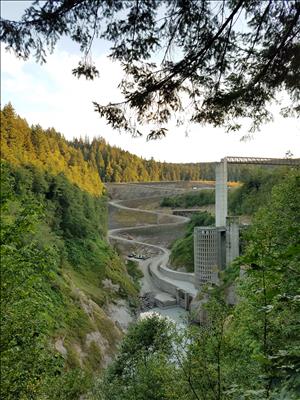When Mud Mountain Dam was completed in 1948, it was the highest rock- and earth-filled dam in the world. The dam was built to prevent massive flooding in South King County and North Pierce County, which used to occur almost annually. Its reservoir contains water filled with glacier flour, which gives the White River its appearance and name.
Beginning in the 1870s, farmers in the White River Valley suffered through floods almost every year. Sometimes, they would dynamite new channels, but this would only shunt the water onto some other farmer’s land. In 1899, an explosion went awry and sent most of the White River into the channel of the Stuck River, originally a little brook that broke off from the White River south of Auburn, and eventually flowed into Commencement Bay.
Dynamiting the landscape was a common ritual for valley farmers, but in 1906 a natural event changed all that. A massive flood broke through the thin barrier that separated the White and the Stuck rivers, sending all of the White River water southward. This was a boon to King County farmers, but a bane for Pierce County farmers.
Too Big a Task
Pierce County sued to restore the White River to its former course. Meetings were held, and district Army engineer Hiram A. Chittenden (1858-1917) was called in for assistance. Chittenden noted that the original path of the White River flowed north to the Duwamish valley, but that its new course to Puget Sound was half as long. “Nature has transferred the course and it will be simpler to perpetuate it than to change it again,” he concluded.
The suit went on for years with no decision. By 1913, both counties came to an agreement -- Pierce County would keep the White River, but King County had to pay 60 percent of flood control. Within a year, construction began on a diversion dam and drift barrier a few miles southwest of Auburn. Later, levees were built and the channel was dredged.
Little good it did. After spending more than $3 million on river modifications, another large flood inundated the valleys in 1933. Realizing that attempts to tame the river were too much for the combined efforts of two county governments, the War Department was called to the rescue.
Dam Builders
After examining earlier studies, and doing their own field work, the Army Engineers decided on a dam that would be located seven miles southeast of Enumclaw. Various designs were considered until they settled on an earthfill dam made of rock, sand, and gravel. The project, named Mud Mountain Dam for a nearby mountain, was authorized by an act of Congress on June 22, 1936.
Roads were cut to the damsite, and land was cleared of trees. In 1937, a camp was built to house the hundreds of men needed to work on the project. The camp had an office building, repair shop, air compressor, mess hall, hospital, bunkhouses for 400 men, and a few family homes. Stores and concessions were not necessary due to the proximity to Enumclaw.
Bids for the project were taken in 1939, and the Guy F. Atkinson Company of San Francisco came in with the lowest bid of $5,344,605. Men worked in three shifts, with an expected completion date of November 15, 1942. But World War II interfered, and the dam was not completed until 1948.
By the Numbers
The earthfill dam is 432 feet high and 1,600 feet thick at the base. Its storage reservoir is 5.5 miles long, and can store 106,000 acre-feet of water. The core of the dam is sand and gravel, and the entire structure is covered with a 3-foot layer of quarry rock to protect against rain wash. The dam has a concrete-lined spillway and two concrete outlet tunnels.
The dam is built with 2.3 million cubic yards of sand, rock, and gravel. Although water has never spilled over the top, an extra nine feet were added in 1991. Water in the reservoir contains a glacial rock flour which gives the White River its appearance and name.
Once the dam was in operation, Puyallup Valley farmers in Pierce County never had to worry about massive flood damage again. Modifications have been made to the dam to improve safety and to protect salmon runs. As of the year 2000, it is estimated that the dam has prevented more than $300 million in flood damages.

